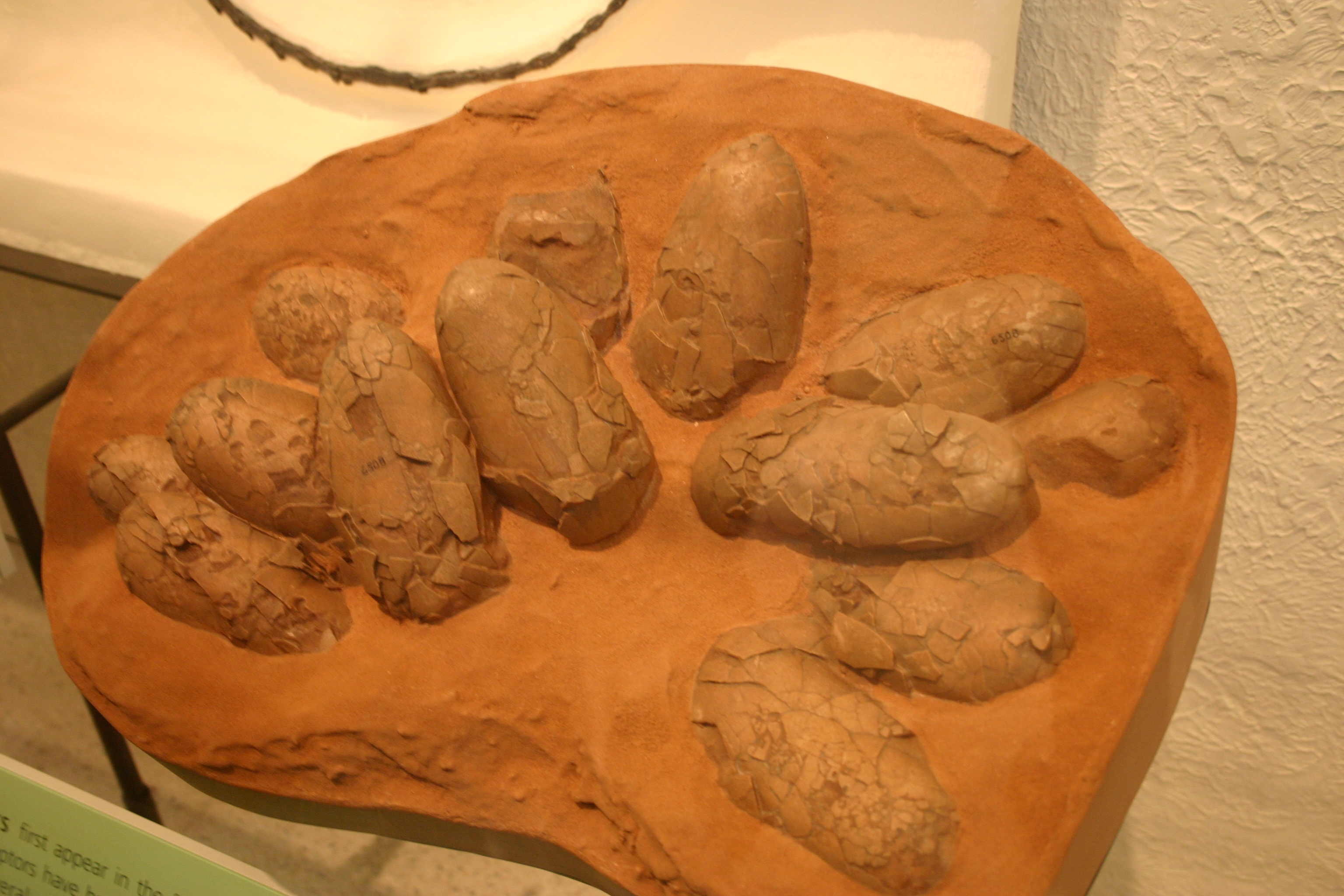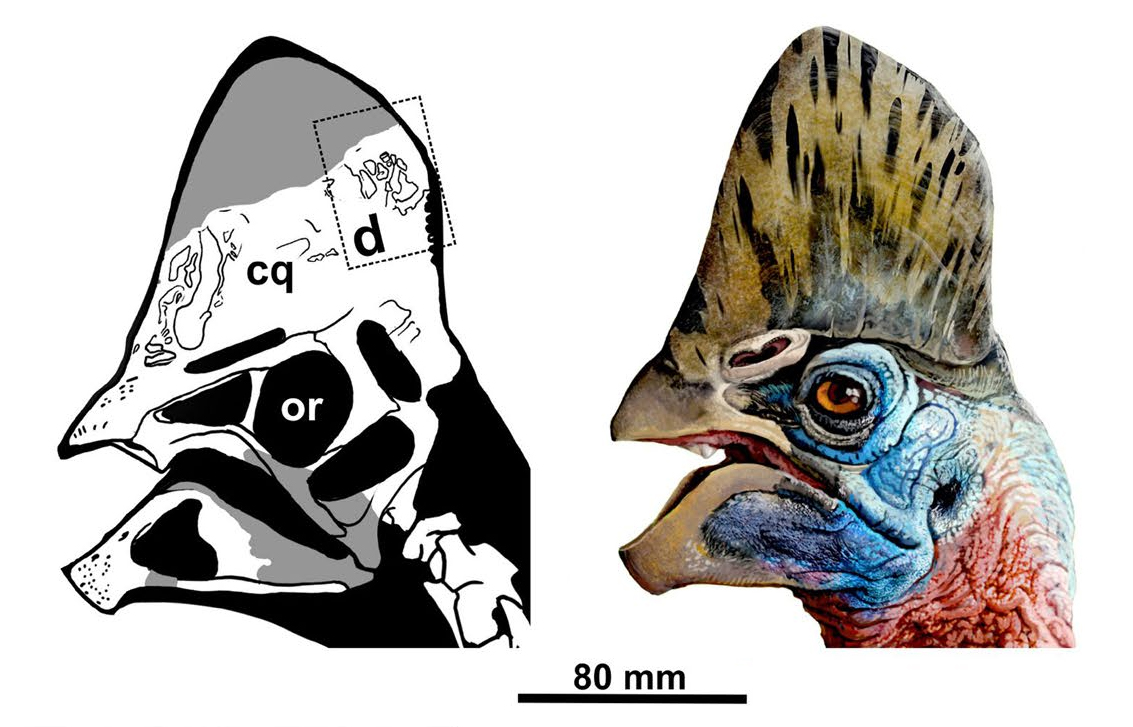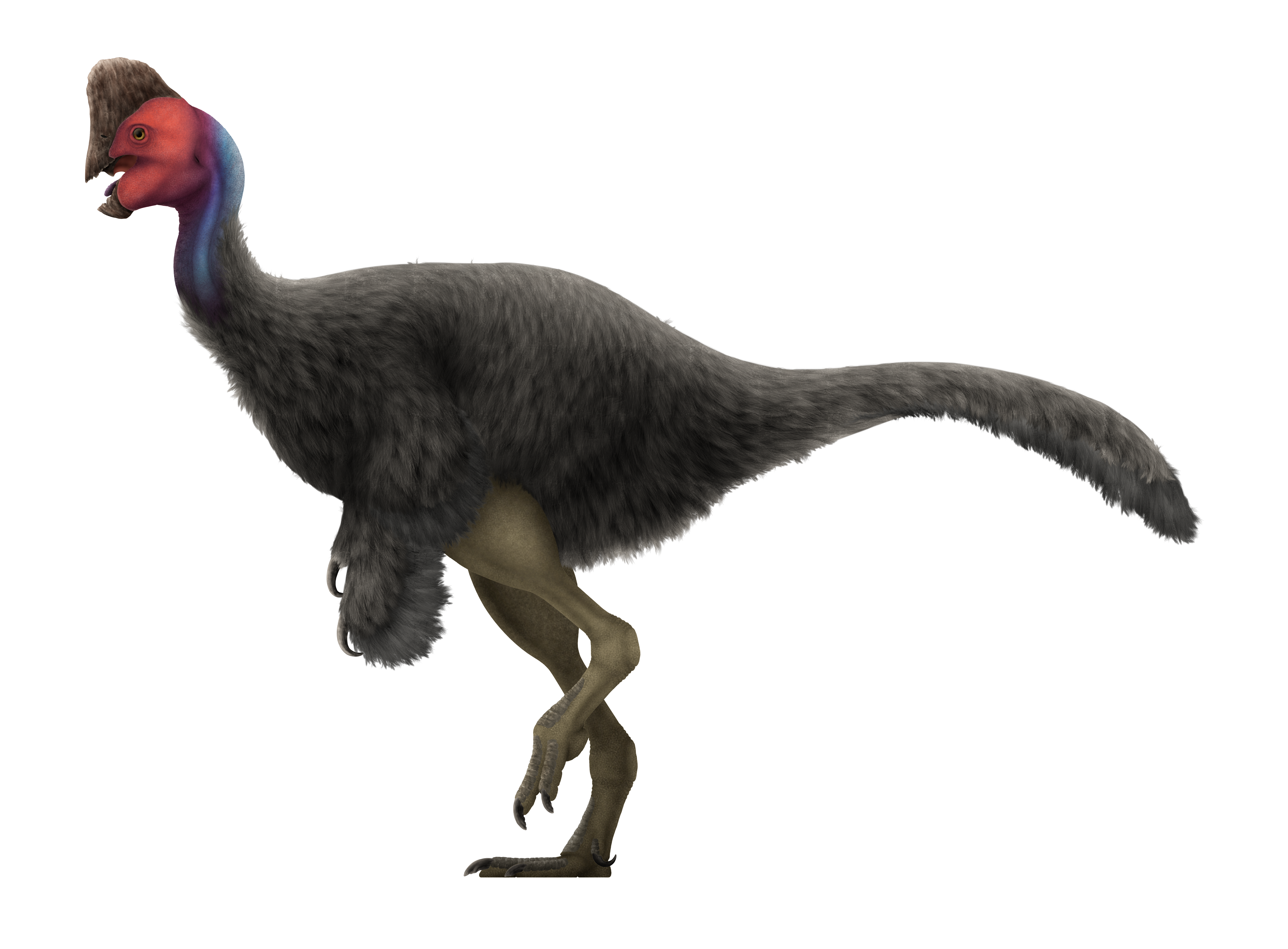|
Oviraptorids
Oviraptoridae is a group of bird-like, herbivorous and omnivorous maniraptoran dinosaurs. Oviraptorids are characterized by their toothless, parrot-like beaks and, in some cases, elaborate crests. They were generally small, measuring between one and two metres long in most cases, though some possible oviraptorids were enormous. Oviraptorids are currently known only from the Late Cretaceous of Asia, with the most well-known species and complete specimens found only in the Gobi Desert of Mongolia and northwestern China. Description The most characteristic feature of this group is the skull structure. Oviraptorids had short snouts and very deep mandibles. Some taxa (such as ''Citipati'', ''Corythoraptor'', ''Rinchenia'') had a midline crest on top of the skull, resembling that of a cassowary. Other distinguishing characteristics include a bony spike intruding on the mandibular fenestra, nostrils placed very high and far back on the snout, an extremely thin bony bar beneath the ey ... [...More Info...] [...Related Items...] OR: [Wikipedia] [Google] [Baidu] |
Nemegtomaia
''Nemegtomaia'' is a genus of oviraptorid dinosaur from what is now Mongolia that lived in the Late Cretaceous Period (geology), Period, about 70million years ago. The first specimen was found in 1996, and became the basis of the new genus and species ''N. barsboldi'' in 2004. The original genus name was ''Nemegtia'', but this was changed to ''Nemegtomaia'' in 2005, as the former name was preoccupied. The first part of the generic name refers to the Nemegt Basin, where the animal was found, and the second part means "good mother", in reference to the fact that oviraptorids are known to have brooded their eggs. The Specific name (zoology), specific name honours the palaeontologist Rinchen Barsbold. Two more specimens were found in 2007, one of which was found on top of a nest with eggs, but the dinosaur had received its genus name before it was found associated with eggs. ''Nemegtomaia'' is estimated to have been around 2 m (7 ft) in length, and to have weighed 40 k ... [...More Info...] [...Related Items...] OR: [Wikipedia] [Google] [Baidu] |
Wulatelong
''Wulatelong'' is an extinct genus of basal oviraptorid dinosaur known from the Late Cretaceous Wulansuhai Formation (Campanian stage) of Bayan Mandahu, Linhe District of Inner Mongolia, northern China. It contains a single species, ''Wulatelong gobiensis''. History The fossils of ''Wulatelong'', representing a single nearly-complete skeleton, now cataloged IVPP V 18409, were discovered in 2009 in the Bayan Mandahu area of Wulatehouqi, Inner Mongolia, a fossil-rich area which has yielded many recent dinosaur discoveries. The authors of the paper describing ''Wulatelong'' had previously described the dromaeosaurid ''Linheraptor'' (2010), the alvarezsaurid ''Linhenykus'' (2011), and the troodontid ''Linhevenator'' (2011). ''Wulatelong'' was described by Xu ''et al.'' in 2013. The generic name derives from ''Wulate'', where the fossils were discovered, and ''long'', the Chinese word for "dragon". The specific name, ''gobiensis'', refers to the Gobi Desert. Classification ''Wulatel ... [...More Info...] [...Related Items...] OR: [Wikipedia] [Google] [Baidu] |
Oviraptor Philoceratops
''Oviraptor'' (; ) is a genus of oviraptorid dinosaur that lived in Asia during the Late Cretaceous period. The first remains were collected from the Djadokhta Formation of Mongolia in 1923 during a paleontological expedition led by Roy Chapman Andrews, and in the following year the genus and type species ''Oviraptor philoceratops'' were named by Henry Fairfield Osborn. The genus name refers to the initial thought of egg-stealing habits, and the specific name was intended to reinforce this view indicating a preference over ceratopsian eggs. Despite the fact that numerous specimens have been referred to the genus, ''Oviraptor'' is only known from a single partial skeleton regarded as the holotype, as well as a nest of about fifteen eggs and several small fragments from a juvenile. ''Oviraptor'' was a rather small feathered oviraptorid, estimated at long with a weight between . It had a wide lower jaw with a skull that likely had a crest. Both upper and lower jaws were toothles ... [...More Info...] [...Related Items...] OR: [Wikipedia] [Google] [Baidu] |
Gobiraptor
''Gobiraptor'' is a genus of oviraptorid maniraptoran dinosaur from the Maastrichtian-age Nemegt Formation of Mongolia. The type and only species is ''Gobiraptor minutus'', known from a single incomplete specimen—the holotype MPC-D 102/111. It has been found not to be closely related to the other oviraptorids it shared its environment with. Discovery and naming In 2008, the Korea-Mongolia International Dinosaur Expedition discovered an oviraptorosaurian skeleton at the Altan Uul III site in Ömnögovi Province, in the Gobi Desert. The fossil was prepared by Do Kwon Kim. In 2019, the type species ''Gobiraptor minutus'' was named and described by Sungjin Lee, Yuong-Nam Lee, Anusuya Chinsamy, Lü Junchang, Rinchen Barsbold and Khishigjav Tsogtbaatar. The generic name combines a reference to the Gobi with a Latin ''raptor'', "robber". The specific name means "the minute one" in Latin, a reference to the small size of the type specimen. Because the name was published in an elect ... [...More Info...] [...Related Items...] OR: [Wikipedia] [Google] [Baidu] |
Oviraptor
''Oviraptor'' (; ) is a genus of oviraptorid dinosaur that lived in Asia during the Late Cretaceous period. The first remains were collected from the Djadokhta Formation of Mongolia in 1923 during a paleontological expedition led by Roy Chapman Andrews, and in the following year the genus and type species ''Oviraptor philoceratops'' were named by Henry Fairfield Osborn. The genus name refers to the initial thought of egg-stealing habits, and the specific name was intended to reinforce this view indicating a preference over ceratopsian eggs. Despite the fact that numerous specimens have been referred to the genus, ''Oviraptor'' is only known from a single partial skeleton regarded as the holotype, as well as a nest of about fifteen eggs and several small fragments from a juvenile. ''Oviraptor'' was a rather small feathered oviraptorid, estimated at long with a weight between . It had a wide lower jaw with a skull that likely had a crest. Both upper and lower jaws were toothless ... [...More Info...] [...Related Items...] OR: [Wikipedia] [Google] [Baidu] |
Corythoraptor
''Corythoraptor'' () is a genus of oviraptorid dinosaur from the late Maastrichtian Nanxiong Formation of South China. It contains one species, ''C. jacobsi'', known from a single well-preserved skeleton, and named after paleontologist Louis L. Jacobs. It bears a tall crest similar to that of the modern cassowary, and possibly had a similar functionality of display and resonance to detect lower-frequency sounds. Like other oviraptorids, the bones of ''Corythoraptor'' were heavily pneumatized with many air pockets. Microanalysis of the bones indicates seasonal growth spurts, and the type specimen probably died at the age of 6 or 7, meaning growth continued into at least the 8th year of development. The type specimen reached in length. Oviraptorids may have predominantly inhabited arid environments and ate xerophytic (drought-resistant) plants, nuts, and seeds. However, ''Corythoraptor'' coexisted with six other oviraptorid genera, and they may have all eaten different foods ( ... [...More Info...] [...Related Items...] OR: [Wikipedia] [Google] [Baidu] |
Yulong Mini
''Yulong'' is an extinct genus of derived oviraptorid theropod dinosaur known from the Late Cretaceous Qiupa Formation of Henan Province, central China. It contains a single species, ''Yulong mini''. It is known from many juvenile specimens that represent some of the smallest known oviraptorids and also a single subadult specimen. Discovery and naming Specimens of ''Yulong'' were collected near Qiupa Town in Luanchuan County, Henan Province, from the Qiupa Formation. The exact geological age of the Qiupa Formation is unknown, but it probably dates to the Late Cretaceous based on the presence of oviraptorids (''Yulong''), dromaeosaurids (''Luanchuanraptor''), ornithomimids (''Qiupalong''), alvarezsaurs (''Qiupanykus'') and other, undescribed, derived dinosaur specimens. ''Yulong'' was first described and named by Junchang Lü, Philip J. Currie, Li Xu, Xingliao Zhang, Hanyong Pu and Songhai Jia in 2013 and the type species is ''Yulong mini''. The generic name is derived fr ... [...More Info...] [...Related Items...] OR: [Wikipedia] [Google] [Baidu] |
Khaan
''Khaan'' (; from Mongol 'lord') was an oviraptorid dinosaur that was found in the Djadochta Formation of Mongolia and lived in the Late Cretaceous Period (Campanian), 75-71 million years ago. Description ''Khaan'' did not differ much from other oviraptorids. At first, its remains were assigned to " Ingenia", but the ''Khaan'' manual structure, lacking the expansion of the upper third metacarpal, was considered to differ sufficiently from that of "Ingenia" for it to be assigned to its own genus. The oviraptorid diet is disputed, with plants and molluscs having been suggested. Like other oviraptorids, ''Khaan'' was probably at least partially a meat eater, feeding on small vertebrates like mammals, lizards and possibly other small dinosaurs. It was also probably feathered. Discovery The type species ''Khaan mckennai'' was in 2001 named by James M. Clark e.a. The genus name is derived from Mongol ''khaan'', "lord" or "ruler". The specific name honours the paleontologist ... [...More Info...] [...Related Items...] OR: [Wikipedia] [Google] [Baidu] |
Jiangxisaurus
''Jiangxisaurus'' is an extinct genus of oviraptorid theropod dinosaur from the Late Cretaceous Nanxiong Formation of southern China. It was similar to ''Heyuannia'', but with more strongly curved anterior claws and a thinner, frailer mandible. This find is paleontologically significant because it contributes to current knowledge about the paleogeographical distribution of oviraptorids in southern China. It was most likely a herbivorous animal along with its close relatives '' Nankangia'' and '' Ganzhousaurus''. Etymology The genus name ''Jiangxisaurus'', refers to the Jiangxi Province of southern China. The specific name ''ganzhouensis'', is derived from Ganzhou, the locality where the specimen was discovered. ''Jiangxisaurus'' was described and named by Wei Xuefang, Pu Hanyong, Xu Li, Liu Di, and Lü Junchang in 2013 and the type species is ''Jiangxisaurus ganzhouensis''. Description The holotype specimen HGM41-HIII0421 consists of an incomplete skull, a lower jaw, ei ... [...More Info...] [...Related Items...] OR: [Wikipedia] [Google] [Baidu] |
Heyuannia
''Heyuannia'' ("from Heyuan") is a genus of oviraptorid dinosaur that lived in Asia during the Late Cretaceous epoch, in what is now China and Mongolia. It was the first oviraptorid found in China; most others were found in neighbouring Mongolia. Two species are known: ''H. huangi'', named by Lü Junchang in 2002 from the Dalangshan Formation; and ''H. yanshini'', originally named as a separate genus ''Ingenia'' from the Barun Goyot Formation by Rinchen Barsbold in 1981, and later renamed to ''Ajancingenia'' in 2013 due to the preoccupation of ''Ingenia''. The latter name was eventually discarded due to various ethical issues surrounding the author. Discovery and naming ''H. huangi'' The type species, ''Heyuannia huangi'', was named and described by Lü Junchang in 2002. The generic name refers to the city of Heyuan. The specific name honours Huang Dong, the director of the Heyuan Museum. The holotype, HYMV1-1, was discovered in Guangdong near Huangsha in layers of the Dalang ... [...More Info...] [...Related Items...] OR: [Wikipedia] [Google] [Baidu] |
Ganzhousaurus
''Ganzhousaurus'' (meaning "Ganzhou lizard") is an extinct genus of oviraptorid dinosaur known from the Late Cretaceous Nanxiong Formation of Nankang County, Ganzhou City of Jiangxi Province, southern China. It was found in a Maastrichtian deposit and contains a single species, ''Ganzhousaurus nankangensis''. It is distinguished by a combination of primitive and derived features. Phylogeny Phylogenetic analysis places ''Ganzhousaurus'' within Oviraptoridae. Within Oviraptoridae its phylogenetic position is more unstable, with one phylogenetic analysis recovering it as a member of the Oviraptorinae and another recovering it as a more derived member of the group, closely related to "ingeniines" However, it also bears some similarities to the basal caenagnathid ''Gigantoraptor''. Paleobiology ''Ganzhousaurus'' shared its habitat with at least four other oviraptorid species, '' Jiangxisaurus ganzhouensis, Nankangia jinzhouensis, Banji long,'' and an as-yet unnamed species. This ... [...More Info...] [...Related Items...] OR: [Wikipedia] [Google] [Baidu] |
Rinchenia
''Rinchenia'' (named after Byambyn Rinchen) is a genus of oviraptorid dinosaur that lived in Asia during the Late Cretaceous epoch in what is now Mongolia, Nemegt Formation, around 70 million years ago. The type and only known species, ''Rinchenia mongoliensis'', was originally classified as a species within the genus ''Oviraptor'' (named ''Oviraptor mongoliensis''), but a subsequent rexamination found differences significant enough to warrant a separate genus. The name ''Rinchenia'' was coined for this new genus, though not formally described in detail. History of discovery During 1984, a nearly complete oviraptorid skeleton was discovered at the Altan Uul II (or Altan Ula II) locality of the highly fossiliferous Nemegt Formation, Gobi Desert. This newly collected specimen, MPC-D 100/32-A, included the skull and lower jaws in their entirety, nearly complete vertebral column, forelimbs with shoulder girdle, and partial hindlimbs with pelvic girdle. Later on, Mongolian paleontol ... [...More Info...] [...Related Items...] OR: [Wikipedia] [Google] [Baidu] |









